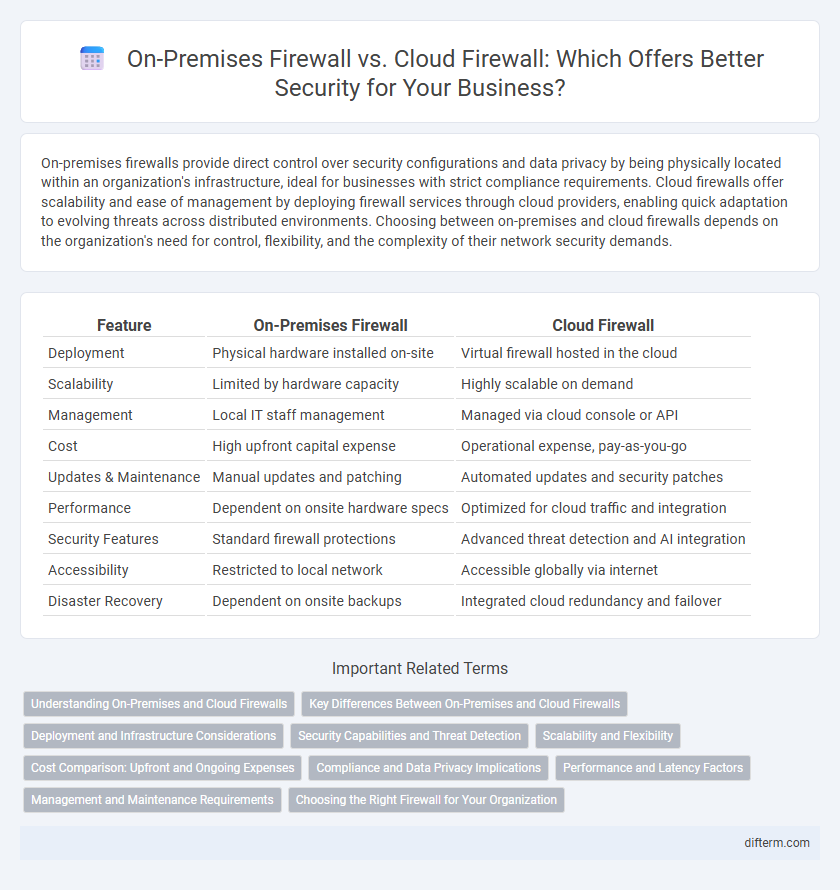On-premises firewalls provide direct control over security configurations and data privacy by being physically located within an organization's infrastructure, ideal for businesses with strict compliance requirements. Cloud firewalls offer scalability and ease of management by deploying firewall services through cloud providers, enabling quick adaptation to evolving threats across distributed environments. Choosing between on-premises and cloud firewalls depends on the organization's need for control, flexibility, and the complexity of their network security demands.
Table of Comparison
| Feature | On-Premises Firewall | Cloud Firewall |
|---|---|---|
| Deployment | Physical hardware installed on-site | Virtual firewall hosted in the cloud |
| Scalability | Limited by hardware capacity | Highly scalable on demand |
| Management | Local IT staff management | Managed via cloud console or API |
| Cost | High upfront capital expense | Operational expense, pay-as-you-go |
| Updates & Maintenance | Manual updates and patching | Automated updates and security patches |
| Performance | Dependent on onsite hardware specs | Optimized for cloud traffic and integration |
| Security Features | Standard firewall protections | Advanced threat detection and AI integration |
| Accessibility | Restricted to local network | Accessible globally via internet |
| Disaster Recovery | Dependent on onsite backups | Integrated cloud redundancy and failover |
Understanding On-Premises and Cloud Firewalls
On-premises firewalls are physical devices installed within a company's infrastructure, providing direct control over network traffic and enhanced security customization tailored to specific organizational needs. Cloud firewalls, also known as firewall-as-a-service (FWaaS), operate in a virtual environment, offering scalable protection across distributed cloud resources and remote users without the limitations of hardware maintenance. Understanding their differences is crucial for implementing a security strategy that balances control, flexibility, and cost efficiency.
Key Differences Between On-Premises and Cloud Firewalls
On-Premises firewalls provide direct control over hardware and data, offering robust security tailored to specific organizational environments but require significant maintenance and upfront costs. Cloud firewalls deliver scalable, flexible protection managed by service providers, enabling rapid deployment and automatic updates while relying on internet connectivity for operation. Key differences include deployment location, management responsibility, scalability, and integration with cloud-native services, impacting overall security posture and operational efficiency.
Deployment and Infrastructure Considerations
On-premises firewalls require substantial physical infrastructure and ongoing maintenance, making them ideal for organizations with stringent data control and compliance needs. Cloud firewalls offer flexible deployment models, reducing hardware dependencies and enabling scalable security across distributed environments. Selecting between these solutions hinges on an organization's infrastructure readiness, budget constraints, and desired level of control over data traffic management.
Security Capabilities and Threat Detection
On-premises firewalls provide granular control over network traffic with deep packet inspection and customized rule sets tailored to specific enterprise environments. Cloud firewalls leverage scalable threat intelligence and machine learning algorithms to detect and mitigate advanced threats in real-time across distributed networks. Both security models incorporate intrusion prevention systems (IPS) and application-layer filtering, but cloud firewalls offer enhanced visibility and automated response capabilities through continuous updates and integration with global threat databases.
Scalability and Flexibility
On-premises firewalls offer limited scalability due to hardware constraints, requiring costly upgrades for increased capacity, while cloud firewalls leverage elastic resources allowing seamless scaling to meet fluctuating traffic demands. Cloud firewalls provide enhanced flexibility by enabling rapid policy adjustments and integration with various cloud services, contrasting with the rigid configurations and slower deployment times typical of on-premises solutions. Organizations prioritize cloud firewalls for dynamic and scalable security postures that adapt quickly to changing network environments and evolving threat landscapes.
Cost Comparison: Upfront and Ongoing Expenses
On-premises firewalls require significant upfront investment in hardware, software licenses, and installation, along with ongoing expenses for maintenance, updates, and skilled personnel. Cloud firewalls operate on a subscription or usage-based model, reducing initial costs while scaling expenses according to network demand and providing automated updates. Evaluating total cost of ownership for both options involves analyzing capital expenditures versus operational expenditures, considering long-term scalability and resource allocation.
Compliance and Data Privacy Implications
On-premises firewalls offer greater control over compliance with industry regulations like GDPR and HIPAA by keeping data within the organization's own infrastructure, reducing risks related to third-party access. Cloud firewalls provide scalable security but require thorough vetting of cloud providers' data privacy policies and certifications such as ISO 27001 or SOC 2 to ensure compliance. Organizations must balance data sovereignty and visibility with the cloud's flexibility to meet stringent regulatory requirements effectively.
Performance and Latency Factors
On-premises firewalls offer low latency and consistent performance by processing traffic locally, eliminating the dependency on internet connectivity and reducing round-trip delays. Cloud firewalls provide scalable resources and centralized management but may introduce latency due to data traversing public internet or VPN tunnels. Performance in cloud firewalls depends heavily on the provider's infrastructure and proximity to the user, whereas on-premises solutions rely on internal network capacity and hardware specifications.
Management and Maintenance Requirements
On-Premises Firewalls require dedicated IT staff for regular updates, patch management, and hardware maintenance, leading to higher operational overhead. Cloud Firewalls offer centralized management through web-based consoles and automated updates, reducing the burden on internal teams. Scalability in cloud firewalls also streamlines maintenance by dynamically adjusting resources without manual intervention.
Choosing the Right Firewall for Your Organization
Selecting the right firewall involves evaluating your organization's security needs, infrastructure complexity, and compliance requirements. On-premises firewalls offer granular control and direct physical security but require significant maintenance and upfront investment. Cloud firewalls deliver scalable, flexible protection with simplified management and rapid deployment, ideal for dynamic environments and remote workforce security.
On-Premises Firewall vs Cloud Firewall Infographic

 difterm.com
difterm.com